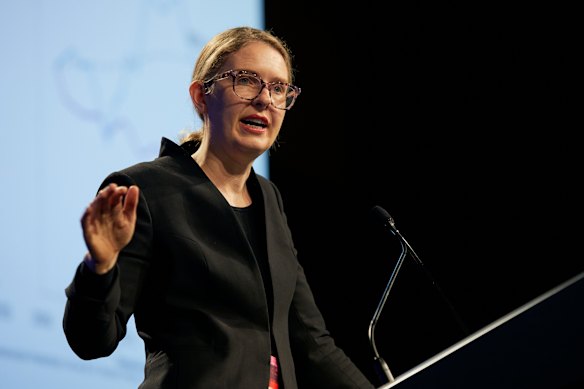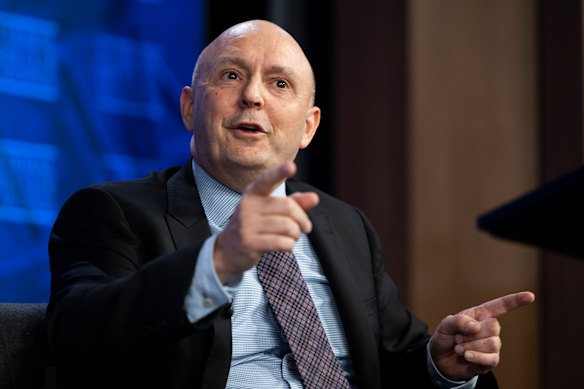Opinion
Roundtable warning: When they say ‘modelling’ grab your bulldust detector
Ross Gittins
Economics EditorThe warm-up for next month’s three-day economic roundtable has begun, and this week we’ll start hearing from worthies who know exactly what we should do to improve our productivity. What’s more, they have the modelling to prove it.
Did you see last week’s headline that “Productivity boost would make workers $14,000 richer”? It was attached to the news that this week Productivity Commission boss Danielle Wood will release a report recommending the government overhaul company tax, speed up planning approvals for infrastructure projects and embrace artificial intelligence.

We’re going to hear about the results of a lot of modelling exercises.Credit: Louie Douvis
And doing this would lead to Australia’s full-time workers being $14,000 a year better off within a decade, would it? Well, no. That’s not what she said. It was that if our productivity performance could return to its long-term average, then that would translate into every full-time worker being $14,000 a year better off by 2035.
So, there was no actual link between what she wanted us to do and this mere calculation of what a return to the higher rate of productivity improvement in our past would do to our pay cheques in the present.
But even this simple calculation assumes that, should a return to a higher annual rate of improvement in productivity come about, the workers would get their fair share of the proceeds.
My point is, we’re about to hear many worthies proposing we do more of this or more of that particular thing because it will improve the economy’s “productivity” – its ability to turn the same quantity of labour, capital equipment and raw materials into a greater quantity of goods and services than before.
When it comes to productivity, it’s always the modeller telling the model what to think, not the other way around.
Sometimes they’ll advocate change X because they genuinely believe it would make the rest of us better off, and sometimes it’s just themselves they’re hoping to benefit. But, either way, many of them will try to make their argument more persuasive by producing “modelling” showing how much better off we’d be.
Let me tell you something, the politicians, businesspeople and economists who wave it in our faces never bother to: modelling isn’t all it’s cracked up to be. It can’t tell you much you didn’t already know except the answer to very complicated sums.
It allows to you to say, “if I assume A, B, C ... and K, what would that do to the rate of economic growth, employment and incomes, given that the economy works the way economic theory says it does?”
There’s a class of modelling using “computable general equilibrium” (CGE) models that’s very popular in Australia, though less so overseas. These models are often used to measure the likely effects of a change in government policy or of a proposed major infrastructure project.
It’s a safe bet we’ll be told the results of a lot of such modelling exercises before, during and after the roundtable. Just remember that modelling is more about helping me sell my idea to you than about finding out whether my great idea would actually work and, if so, how well.
The problem with economists is that they’re much more about religious faith than scientific inquiry. Our economics profession’s leading sceptic is Dr Richard Denniss, director of the Australia Institute. Other economists know what he knows and share his reservations, but they keep it to themselves.
With Matt Saunders, Denniss has written a paper on the limits of CGE modelling, which would make enlightening reading for many. “General equilibrium” means the model is designed to take in the whole economy, not just one part of it.
“Part of the persuasive power of CGE models comes from the perception that they contain a large amount of objective mathematics and theory,” they say. But while these models “contain many equations, this is not the same thing as a large amount of objectivity.

Productivity Commission head Danielle Wood.Credit: Louis Trerise
“The modeller needs to make decisions about the values of thousands, potentially millions, of model variables. It is not the model that estimates the many inputs for which no good data is available, it is the modeller and the modeller’s client that makes such choices.”
One way of viewing the economy is to say that the growth in real gross domestic product is determined by “the three Ps”: population growth, the proportion of the population that participates in the labour force, and the rate of improvement in the productivity of labour.
With these models, all three of those Ps are “exogenous variables”. That is, the modeller makes their best guess on what will happen to population growth, the rate of participation and the rate improvement in labour productivity, then punches them into the model and turns the handle to see what it says will happen to economic growth, employment and all the rest.
This means modelling can tell us little about productivity. If you had a list of things you wanted to do because you thought they’d improve productivity, the model couldn’t tell you whether each of them really would improve productivity, nor by how much all of them would improve it.

Dr Richard Denniss, Australia Institute executive director.Credit: Alex Ellinghausen
So, for instance, modelling can’t tell us whether cutting the rate of company tax would do more for productivity than, say, doubling government support for research and development. When it comes to productivity, it’s always the modeller telling the model what to think, not the other way around.
The great contradiction of modelling is that, while you have to be really good at maths to run a model, let alone build one, and really good at economics to build one that makes sense, the economy you end up modelling is so grossly oversimplified it’s like a world inhabited by stick figures.
Unlike all the people happily quoting modelling results to us, Denniss and Saunders tell us that, although these models spit out many numbers with dollar signs in front of them, there is no actual money in the model, no interest rates, credit, loans or savings.
The models usually assume that inflation has no effect on the real economy, most assume that the profits in each industry are minimal because competition competes them down, and capital equipment can be repurposed at no cost.
It’s fortunate for economists that their profession has never worried too much about ethics.
Ross Gittins is the economics editor.
The Business Briefing newsletter delivers major stories, exclusive coverage and expert opinion. Sign up to get it every weekday morning.